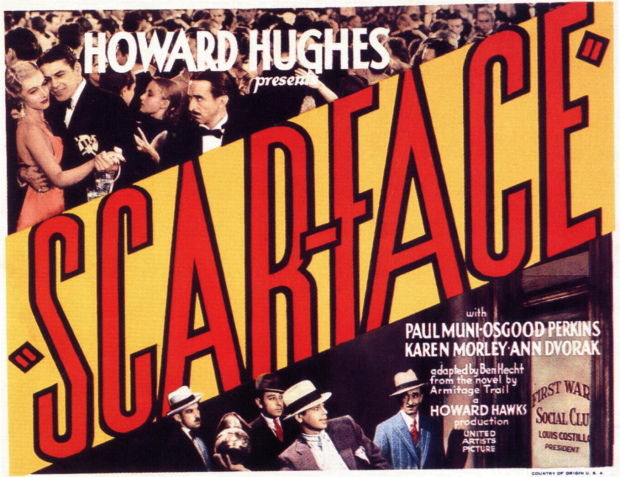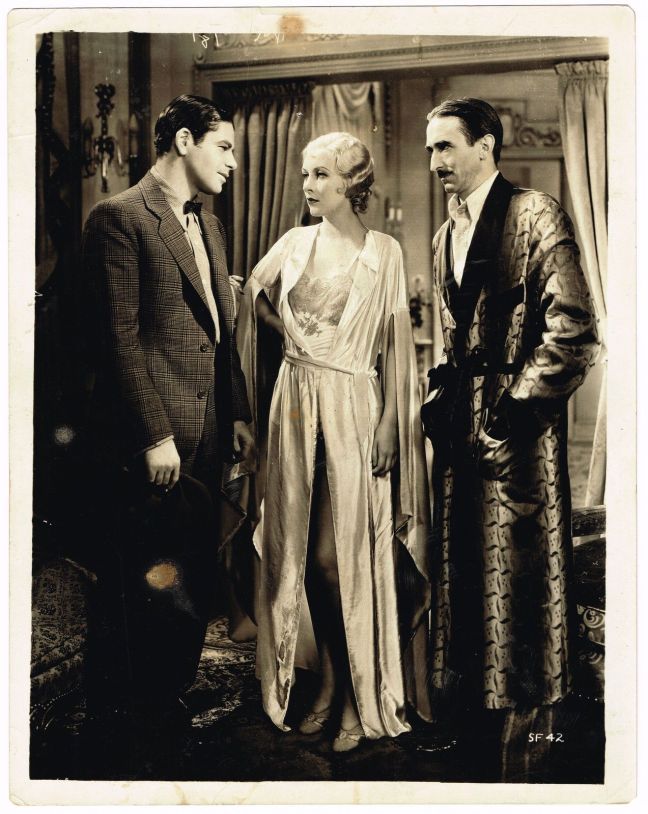Howard Hawks’ gangland epic Scarface is a particularly gritty, nasty, mean-spirited gangster flick. It remains a high point of Pre-Code Cinema – genuinely startling in its intense violence and bizarre, unsavory relationships.
Filmgoers tend to go into films from the 1930s expecting a certain cozy quaintness, perhaps expecting some Shirley Temple cuteness or Marx Brothers hijinks. The films of the early 1930s are a much different, more vicious breed, however. Film-makers were desperate to capture the fascination of audiences using every gimmick at their disposal, as the newly invented “talkies” left movie lovers hungry for innovation.
Like any business, Hollywood’s first response was to create controversy. Movies released before the Hays Code was enforced in earnest in 1934 are a carnival of vice. Drug addiction, wanton sex, alcoholism, unwanted pregnancy, abortion, homosexuality, and intense violence were all too common. You’d even seen your occasional incest, as evident in a bizarre subtext of 1932’s Scarface, which we’ll be discussing in-depth.
The films of the early 1930s are a bridge between the innocence of Early Cinema and the later cynicism of Film Noir. Ironically, the Hays Code played a large part in the creation of that genre, as film-makers had to get savvy and tricky to get around the censors.
Scarface exists in the intersection between these two distinct eras. The non-stop depictions of violence are particularly gritty and realistic, even by today’s standards. This isn’t your usual cinematic action, where a cowboy simply falls from his horse like a cardboard cutout when shot. Instead, the gangsters of Scarface are cut down in a hail of hot lead, reaching for the bullets like a swarm of angry hornets. While censors may have been worried these films were romanticizing violence and criminal behavior, Scarface seems anything but romantic. Instead, these are hard, fast, desperate lives, wedded to the gun and holster.
Let’s take a closer look at 1932’s Scarface.

Scarface (1932) Movie Review
Scarface is considered the last of a triptych of legendary Gangster Movies, alongside Little Caesar and Public Enemy. It’s also the grittiest and most violent, which would tangle the film up in legal complications for 2 years, even before the Hays Code was being enforced in earnest.
Scarface Plot Synopsis
Scarface tells the story of Tony “Scarface” Camonte, played with fervor by Paul Muni, a fictionalized depiction of fearsome Chicago gangster Al Capone. It starts off with Camonte taking out the competition, gunning down Big Louie Costello, the last of the old-world Italian mobsters. With a sudden vacuum in the power balance of Prohibition-era Chicago, Camonte and his new boss Johnny Lovo move in to take over Costello’s action.
Scarface wastes no time in getting to the shooting, but we meet the rest of a memorable cast of characters at the same time. There’s Cesca, played by Ann Dvorak, Camonte’s sister, who he has a particularly protective streak towards. Tony catches her kissing a fella and throws the poor boy out into the street. It’s unclear if Camonte’s just playing the old-world protective patriarch or if there’s a little more to it, just to add to the moral ambiguity of the film.

We also meet Poppy, played by the under-appreciated bombshell Karen Morley, who is lovers with Johnny Lovo at the time. We’ll quickly learn that Poppy’s loyalty is less-than-reliable. As is Tony’s, as he begins to double-cross Johnny Lovo while still serving as his right-hand man.
Lovo and his gang already own the South Side. A mobster named O’Hara owns the North Side and Lovo forbids Camonte from making moves into O’Hara’s territory. Camonte ignores this advice, kick-starting a gang war that sends the public into a panic.

The introduction of Tommy Guns changes the game completely. Camonte finally has the tools he needs to make his move, and the streets of Chicago run red with blood and beer.
Johnny Lovo loses his status as Camonte moves into to seize the power, as the most ruthless, violent gangster the city had ever seen. Poppy finally succumbs to Camonte’s persistent advances, but it’s a little too late at that point.
Camonte orders Johnny Lovo gunned down by Guino, the archetypal coin-flipping movie gangster played by George Raft. Camonte and Poppy pick up stakes and head to Florida to let things cool down. His undoing would be waiting for them immediately upon their return.
While Camonte was in hiding, Cesca makes her intentions clear towards Guino, whom she’s been flirting with throughout the duration of the film. Camonte returns to find his sister gone, living in a small apartment with Guino. Furious, Camonte busts in on the happy couple and cuts down Guino, one of his last friends, in cold blood. It turns out Guino had made an honest woman of Cesca, as the pair had been married just the day before. Destroyed, half-mad, Cesca lays into Tony, calling him a butcher and a murderer.
This mis-step would prove to be Tony’s undoing. The cops catch wind of Guino’s murder and send a squad to Camonte’s bulletproof lair. It turns out to not be bulletproof enough, and the film’s final moments finds Camonte alone and afraid, having lost everything he loved and held dear. He died, as he lived, by the Tommy Gun.

Scarface‘s Critical Reception
Even in the years before the Hays Code was being enforced in earnest, Scarface managed to scandalize very nearly everybody. First of all and unsurprisingly, the usual keepers of morality, the Church and concerned citizens groups, protested the film. Both Irish and Italian groups felt the film cast immigrants in a negative light.
Scarface actually holds to certain tenets of post-Code Hollywood, even if they didn’t need to. Most notably, wrong-doers are punished, which prevents Scarface from feeling like its glamorizing the Gangster lifestyle. Some of these changes were forced, as well, however, as the film underwent extensive reconfiguration over the span of 2 years to please the censors.
This additional material comes largely in the form of a few newsroom scenes, where outraged reporters froth about what this country’s coming to. The exposition is rather heavy-handed, but is salvaged with some passionate delivery by the head reporter.
Given the concern over the depiction of immigrants in Scarface, it’s slightly ironic that the film is one of the least whitewashed, Americanized gangster films out there. The characters are clearly Italian, complete with accents and everything. Never succumbing to stereotypes, Scarface depicts the real struggles of Italian-Americans, complete with some realistic characters, like Tony and Cesca’s mother, who adds even more moral condemnation on the film’s proceedings.
Scarface Final Thoughts
Scarface was ready to be released in 1930, you must remember. This means the United States was reeling from the Great Depression and from the memories of The Great War, aka World War I. Films of this era reflect this loss of innocence and cynicism in a way that would finally blossom into the Flower Of Evil that is Film Noir.
Scarface also reflects this moral universe using strong, striking contrast in the black-and-white film. It can be read as a kind of proto-Film Noir, but is even uglier and more malevolent than that genre, which had to rely on shadows and subtlety to deliver its moral worldview.
Scarface also benefits from some of that era’s more adventurous film-making techniques. Certain moments seem cribbed from the German Expressionist playbook, with weird, cock-eyed angles reflecting an unhinged worldview. All of the technical niceties are nice and all, but they’re mainly setting and stage-dressing for insanely strong performances. Paul Muni is beyond belief as Scarface, who manages to be simultaneously hideous and likable, sometimes in the same scene. The women are strong and sure of themselves, even if they do succumb to the men’s authority. It was still the early ’30s, after all, and the Suffragette movement was still getting going, especially here in the states.
For all of its moralizing, Scarface doesn’t preach. Instead, it tells a tale. It follows deep, intriguing characters as they follow their passions for power and money. Unsurprisingly, they get what they sow. You’re left not really knowing how to feel, which is truly the mark of a thought-provoking, masterful film.
Scarface was screened as the first installment of the Putting The Sin In Cinema series at Cinema 21 in Portland, Or. in conjunction with Oregon State University. The film was screened, and a fascinating follow-up conversation was had with film instructor/programmer/analyst Elliot Lavine.
There’s still 9 weeks of the course left, so it’s not too late if you’d like to join in with some fellow Portland movie fanatics. You can find tickets and register via OSU.
Next week we’ll be taking a look at Three On A Match, also from 1932. Check back next Tuesday for more classic Hollywood movie reviews!
Want More Portland Movie Reviews?
Looking for more movie news, reviews, thoughts, and insights? Follow @for3stpunk on Twitter, Instagram, and Letterboxd!
Want to support quality, in-depth film criticism? Every donation allows us to comment more fully on the world we’re living in.


